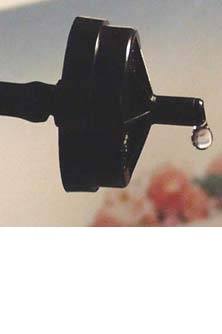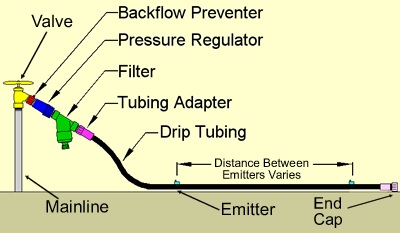 Do a Drip Irrigation Tune-Up - June 3, 2015 Jeff Schalau, Agent, Agriculture & Natural Resources University of Arizona Cooperative Extension, Yavapai County Drip irrigation is an excellent way to deliver appropriate quantities of water to landscape plants. However, drip systems may develop problems seven to ten years after installation. This is about the age when mineral deposits can start to limit the system’s performance and when trees and medium to large shrubs may need more drip emitters. Often, the first sign of drip irrigation failure is a dying plant. Giving your drip system a tune up will likely improve your irrigation efficiency, conserve water in your landscape, and produce healthier plants. A plant is considered "irrigated" when an adequate amount of water is supplied to its root systems. Roots do not seek water. Roots develop where there is soil and periodic water. Deep, less frequent watering encourages deeper roots and more robust plants. Even so, rooting depth has limitations because roots also need oxygen and the deeper you go, the more difficult it becomes for oxygen to diffuse into the soil. Drip irrigation has several advantages: less evaporation and run-off because water soaks directly into the soil; less stress on plants because soil moisture is replenished periodically; and reduced weed growth because water is only applied where plants are growing. Of course, this assumes proper system design, installation, maintenance, and that someone is periodically checking the system to ensure it is performing as it should. To begin giving your drip system a tune up, check to see if you have a filter. If so, disassemble, clean and reassemble the filter. Then remove the end cap(s) and turn on the valve allowing the water to flush out dirt and debris in the main line being careful to prevent soil and debris from entering the open end. Turn off the valve, remove emitters (simply pull them off), replace the end cap and flush the lateral lines for another two or three minutes. While the system is running, replace emitters, and observe for problems. This procedure should also be followed anytime repairs are made to the system. Drip irrigation systems should also have a pressure regulator that reduces incoming water pressure for low-pressure drip systems. Typical household water pressure is 50 to 60 psi while drip systems are designed to operate at around 20 to 30 psi depending on the manufacturer. A typical drip system has the pressure regulator installed just after the filter. During the growing season, periodically check, clean, and/or replace emitters to ensure proper operation. Check for emitters that have popped off tubing because of high pressure, and install or replace the pressure regulator if needed. Check to see that all emitters are in place. Salt/mineral deposits and be removed from emitters by soaking them in vinegar and/or using forced air to blow them out. Look for pinched or broken tubing and straighten or replace it. Missing and broken emitters will need to be replaced. Drip irrigation emitters are sold with either fixed or adjustable output. The output is measured in gallons per hour (GPH). Emitter output can be checked by placing the emitter in a container and measuring the volume after a fixed time interval. For example, if you collected 20 ounces of water over five minutes, this emitter’s output would be about 2 gallons per hour (actually 1.88 GPH). 20 ounces divided by 128 converts it to gallons. Multiply the gallons times 12 to convert 5 minutes to calculate GPH. It is also a good idea to assess whether or not the drip system is adequately providing water to larger plants. Large shrubs and trees are almost always planted with one or two drip emitters placed near the base of the plant. Many sources recommend that emitters be moved outward as these plants grow. I recommend that emitters be added rather than moved. When emitters are simply moved, the roots that were established in the original placement may not get adequate irrigation while you are waiting for new roots to grow toward the new emitter location. In my opinion, drip irrigation can be problematic for these larger plants unless plans are in place to expand the area irrigated over the life of the plant. Multiport drip irrigation heads can accomplish this very well. Next, you should critically assess whether or not a particular plant still needs irrigation. Native and drought-adapted plants are often established after two years of irrigation and may perform adequately without supplemental irrigation. Cacti and succulents are especially drought tolerant. When emitters are removed, install plugs designed especially for this purpose. See below for additional drip irrigation resources. Follow the Backyard Gardener on Twitter – use the link on the BYG website. If you have other gardening questions, call the Master Gardener help line in the Camp Verde office at 928-554-8999 Ext. 3 or e-mail us at verdevalleymg@gmail.com and be sure to include your name, address and phone number. Find past Backyard Gardener columns or provide feedback at the Backyard Gardener web site: http://cals.arizona.edu/yavapai/anr/hort/byg/. Additional Resources  Simple schematic of a drip irrigation system. Drip Irrigation for Home Gardens Colorado State University Extension www.ext.colostate.edu/pubs/garden/04702.html Landscape Irrigation Equipment Part 2: Drip Irrigation Clemson Cooperative Extension www.clemson.edu/extension/hgic/plants/other/irrigation/hgic1811.html Designing A Landscape Drip Irrigation System for Southern Nevada University of Nevada Cooperative Extension www.unce.unr.edu/publications/files/ho/other/fs9382.pdf |